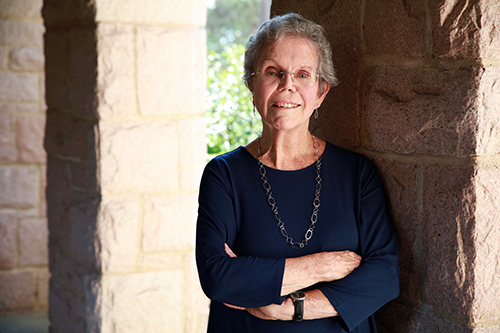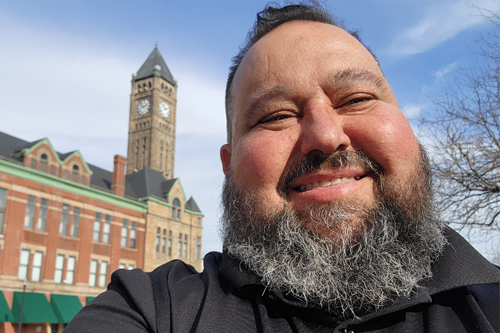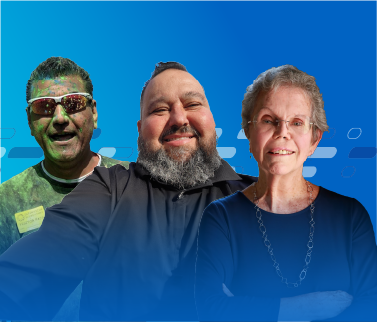For individuals living with a chronic, rare inflammatory disease like severe active ANCA-associated vasculitis (AAV), the journey to and after diagnosis can be long, arduous, challenging and oftentimes lonely. Even though each person’s journey comes with a unique set of hurdles and roadblocks, a common thread woven through all of their stories is the incredible value of the community they’ve built. Three people at different stages of their AAV journey share their experiences and how connection has provided critical support and guidance along the way. The road to diagnosis hasn’t always been smooth sailing but in the end has ignited a strength within to push forward with a little help from some spectacular doctors and new friends.
Words of Wisdom from a Leader in the AAV Community
Dianne Shaw, who has lived with AAV for more than 28 years, has been a steadfast champion and knowledge holder within the community. When her symptoms first started, she believed she just had a cold but after multiple unsuccessful rounds of antibiotics, she and her doctor decided to investigate further. Dianne was eventually diagnosed with granulomatosis with polyangiitis (GPA), a type of AAV, but not before several misdiagnoses, including lung cancer. “I was completely knocked off balance when I first received my diagnosis, because I had never heard of this disease. I had no frame of reference,” Dianne said. “I felt lost and kept looking for anchors. And my anchor was information.”
At the time of Dianne’s diagnosis, there were few treatment options or resources available to patients, so she tapped her years of experience working in advocacy to help find answers. “Being director of communications for a cancer center, I would translate support/coping strategies and practices from cancer to vasculitis,” Dianne explained. As a result, she was not only able to navigate her own journey, but also provide support to other individuals living with AAV by serving as a member and then president of the Vasculitis Foundation board from 2001 to 2008.

Setting Goals to Achieve Small Victories While Living with AAV
Glen Massie has lived with AAV since 2012. His symptoms started as a presumed sinus infection, which became drastically worse as time went on. He started feeling horrendous joint pain and fatigue and eventually was only able to use his left shoulder. While seeing various specialists and undergoing tests to determine a diagnosis, things took a very quick turn for the worse and Glen was rushed to the intensive care unit (ICU), put on a ventilator and placed into a medically induced coma. “When he woke up, his family told him he was diagnosed with GPA, 6 months after his initial symptoms.
After experiencing extreme mobility issues, Glen gradually learned to set small goals for himself like taking short walks down the hallways of the hospital to help him progress. "My physical trainers would tell me it’s going to feel like I’m not doing a lot, but it’s important to look back each day and remember what I did today compared to yesterday,” said Glen, “It made such a big difference to me." This approach eventually helped him build enough strength to be present for major milestones in his and his family’s life, like his son’s graduation, police commissioner ceremony and wedding. “Over the past 12 years, I've worked to set little milestones for myself with goals that were achievable,” added Glen, “You can feel beat down if you look so far ahead and it might seem like you can never get to it, so I would make a check-list and once I completed one, I'd move on to the next.” His experience with GPA inspired him to support the community and start the West Central Ohio chapter of the Vasculitis Foundation.

Taking on AAV One Stride at a Time
One day in 2017, Art Diaz started feeling severe body aches in his shoulder, chest and legs and had trouble breathing, which he had assumed was an injury from running, as he was an avid runner. Art’s wife took him to the emergency room where it was discovered that he had blood clots in his leg that were working their way to his lungs. After a brief stay at the hospital for a suspected heart attack which turned out to be a false alarm, Art went home. But then his symptoms worsened, and he felt extreme fatigue, which eventually led to his diagnosis of GPA – three weeks after Art’s initial symptoms, which is very quick and uncommon for someone with a rare disease like AAV. “Getting the diagnosis was a major relief, because I knew that I could get a treatment,” stated Art, “But little did I know the journey was just beginning.”
Art found it difficult to explain his new situation to his children, who were 5 and 3 years old when he was diagnosed. They would often ask why he couldn’t pick them up from school, which was devastating to hear as a parent but also motivated him to learn more. Art also found himself wondering if he would be able to continue to pursue his passion for running again, given how debilitating his symptoms were. So, Art began educating himself on AAV and found a special community through the Vasculitis Foundation, which opened the door for him to talk to people who understood his situation on a regular basis. Now, six years later, Art has found a new normal. He goes on small walks and runs every day and shares his experiences at in-person patient gatherings to help others who were just like him.

AAV Through a Doctor's Eyes
Dr. Adam Brown, an associate program director of rheumatology at the Cleveland Clinic, knows how winding one’s journey with AAV can be. Over the course of his career, he has treated over 100 vasculitis patients who are usually in a state of crisis by the time they reach him. “The problem with this disease is that it can manifest in ways that are very commonly misconstrued as another diagnosis, which delays proper treatment,” explained Dr. Brown.
Often, these misdiagnoses are due to a typically benign or unassuming symptom like fatigue. However, for a patient with AAV, this fatigue can be incredibly debilitating and a signal that something more significant is at play. Unfortunately, the rarity of AAV makes it difficult for clinicians to diagnose patients quickly. This emphasizes the importance of securing a care team of experienced specialists to obtain a proper diagnosis and develop a treatment plan that is tailored to the patient’s needs. “It's not a solo job. You need providers who are comfortable with this condition. I'm very comfortable in vasculitis, but I still rely on my nephrology, pulmonary and sometimes my infectious disease colleagues to provide comprehensive care,” stated Dr. Brown.

Dr. Adam Brown
While getting treated for AAV quickly is a significant part of a patient’s journey, it’s also important to ensure individuals have a community of sounding boards. Hearing stories from other patients who have gone through similar experiences can be life-changing for those with AAV who may be confused or frustrated by their condition. “When one of my patients first gets diagnosed, I always reiterate that there are advocacy groups like the Vasculitis Foundation to help,” Dr. Brown added. “For patients with a rare disease like AAV, these groups play a vital role in providing them not only emotional support but valuable educational resources on their disease so they can be an active participant in the care they receive.”
To learn more about AAV and what it is like to live with a rare disease, visit the Vasculitis Foundation.





